ResNet网络结构
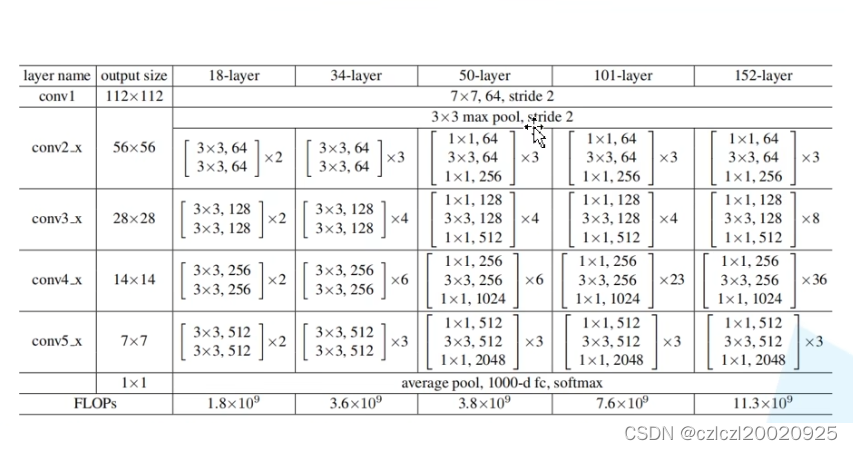
当主分支输出channel与shortcut输出channel不一致时用虚线结构
18和34层ResNet的残差结构
第一种残差结构(实线结构)
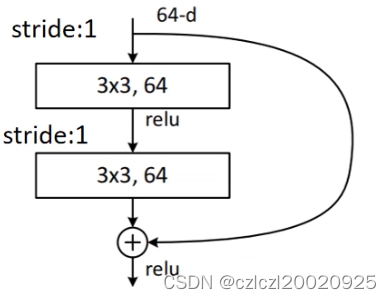
第二种残差结构(虚线结构)
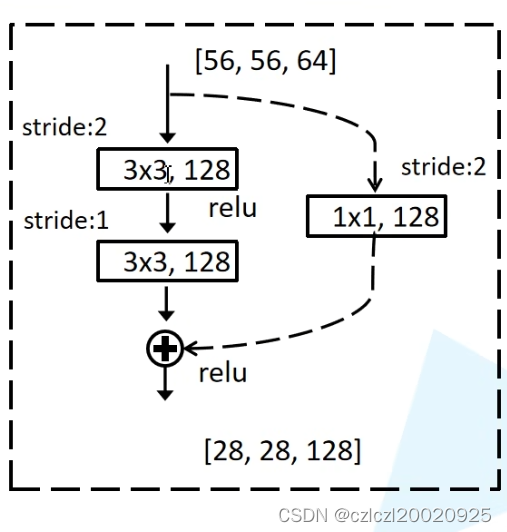
50,101,152层ResNet的残差结构
第一种残差结构
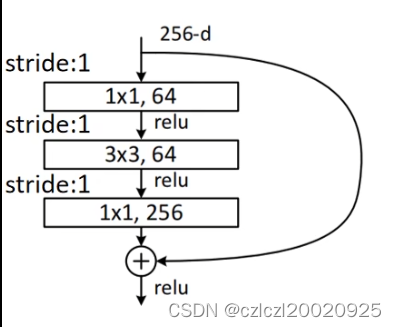
第二种残差结构
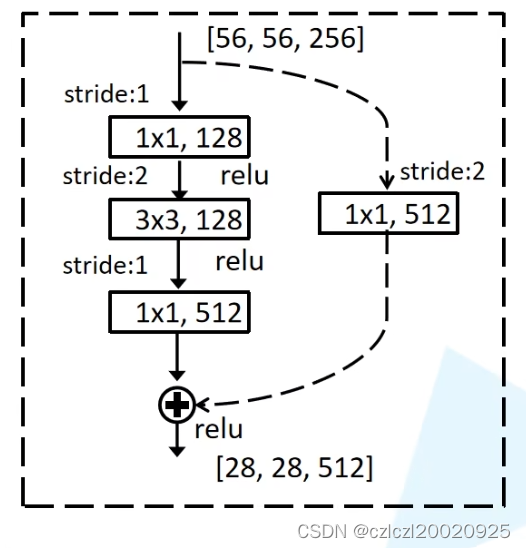
第三种残差结构
仅在conv2_x的第一个残差结构中使用,仅改变channel,不改变size
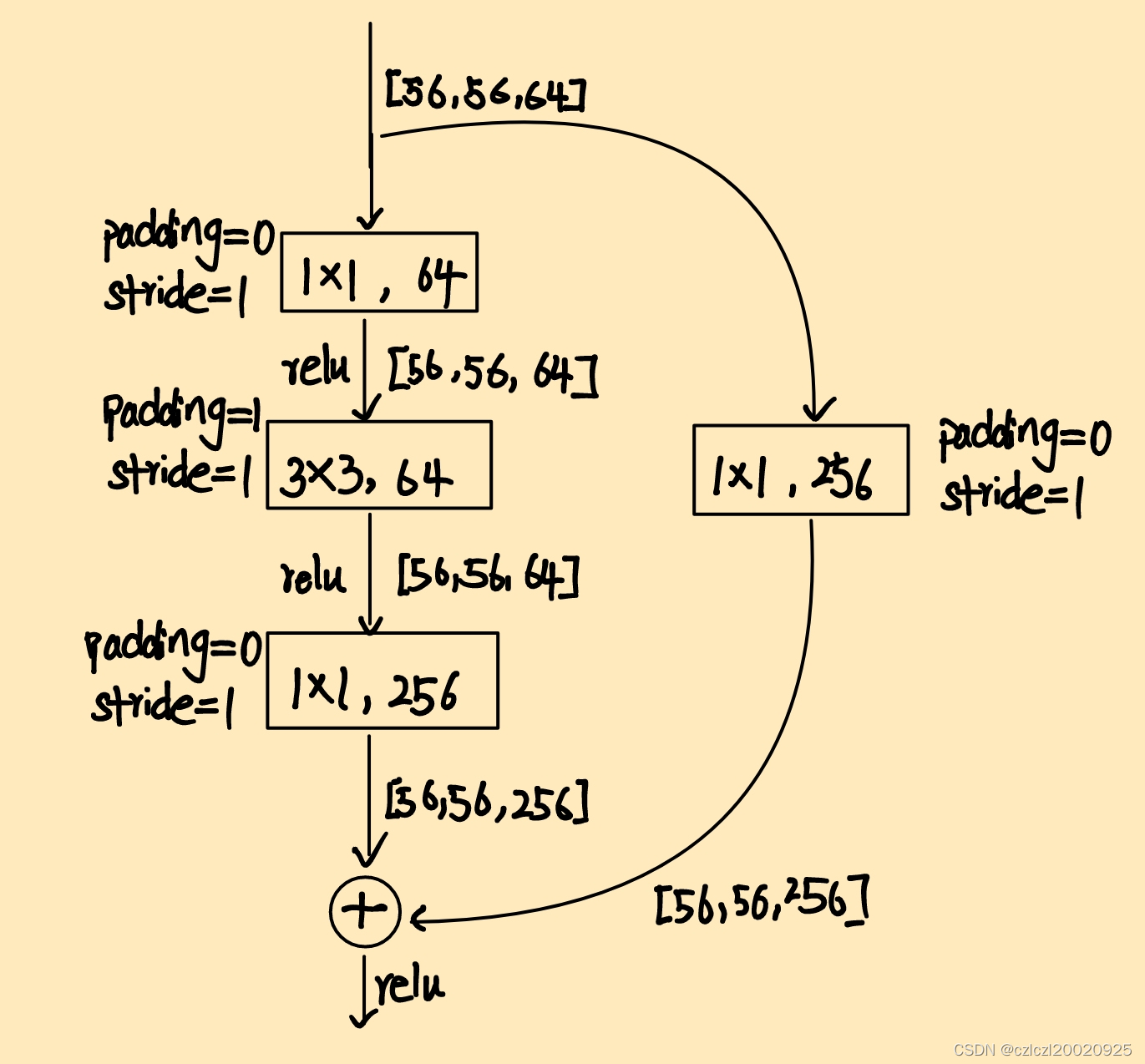
网络层次结构
- (conv1[112*112*3]表示conv1层输出格式为112*112*3)
- 18,34层ResNet与50,101,152层ResNet结构在conv2_x处的第一个卷积层略有不同
- 以18层ResNet为例,其结构为:
conv1[112*112*64] -
conv2_x(maxpool[56*56*64] - 实线结构[56*56*64] - 实线结构[56*56*64]) -
conv3_x(虚线结构[28*28*128] - 实线结构[28*28*128]) -
conv4_x(虚线结构[14*14*256] - 实线结构[14*14*256]) -
conv5_x(虚线结构[7*7*512] - 实线结构[7*7*512]) -
avgpool - linear - softmax - 以50层ResNet为例,其结构为:
conv1[112*112*64] -
conv2_x(maxpool[56*56*64] - 特殊虚线结构[56*56*256] (此虚线结构仅改变了channel而没改变size) - 实线结构[56*56*256] - 实线结构[56*56*256]) -
conv3_x(虚线结构[28*28*512] - 实线结构[28*28*512] - 实线结构[28*28*512] - 实线结构[28*28*512] - 实线结构[28*28*512]) -
conv4_x(虚线结构[14*14*1024] - 实线结构[14*14*1024])… -
avgpool - linear - softmax
### 下面是代码
from torch import nn
# BasicBlock:为18和34层的残差结构,Block中所有卷积层的卷积核数都一样
class BasicBlock(nn.Module):
# expansion用来区分BasicBlock和Bottleneck,Bottleneck的残差结构的最后一个卷积层的输出channel为4*之前几层输出channel,因此其expansion为4
expansion = 1
# out_channel为残差结构输出特征矩阵的channel数(也为主分支上卷积层的卷积核数),
# 第一种实线残差结构所有的卷积层stride默认为1,第二种虚线残差结构stride不全为1
# 参数中stride为主分支第一个卷积层以及shortcut中卷积的stride(实线结构中为1,虚线结构中为2)
# downsample下采样为True时,此残差block的shortcut需要调整channel来与主路径的channel匹配,之后再相加
def __init__(self, in_channels, out_channels, downsample=False):
super(BasicBlock, self).__init__()
# stride(实线结构中为1,虚线结构中为2)
stride = 1
if downsample:
stride = 2
# 18和34层的残差结构的kernelsize都为3
# 18,34层实线残差结构stride为1,为保证输出特征矩阵宽高不变,padding也为1
# 18,34层虚线残差结构主分支第一个卷积层以及shortcut中卷积的stride为2,为保证输出特征矩阵宽高变为1/2,padding也为1
self.conv1 = nn.Conv2d(in_channels, out_channels, kernel_size=3, stride=stride, padding=1)
# BatchNorm2d(param),param:输入BN层的特征矩阵的深度/channel数
self.bn1 = nn.BatchNorm2d(out_channels)
self.relu = nn.ReLU(True)
# 这里的stride为1,因为无论实线残差结构还是虚线残差结构的conv2的stride都为1
self.conv2 = nn.Conv2d(out_channels, out_channels, kernel_size=3, stride=1, padding=1)
self.bn2 = nn.BatchNorm2d(out_channels)
self.downsample = downsample
self.shortcut_conv = nn.Conv2d(in_channels, out_channels, kernel_size=1, stride=stride, padding=0)
def forward(self, x):
# 如果不是第二种虚线残差结构(需要调整shortcut的channel),则shortcut_output就为x
shortcut_output = x
if self.downsample is not False:
# shortcut分支要调整channel
shortcut_output = self.shortcut_conv(x)
x = self.conv1(x)
x = self.bn1(x)
x = self.relu(x)
x = self.conv2(x)
x = self.bn2(x)
x += shortcut_output
x = self.relu(x)
return x
# Bottleneck:为50,101,152层的残差结构,Block中最后一个卷积层的卷积核数量为之前两层卷积核数量的4倍
class BottleNeck(nn.Module):
# expansion用来区分BasicBlock和Bottleneck,Bottleneck的残差结构的最后一个卷积层的输出channel为4*之前几层输出channel,因此其expansion为4
expansion = 4
# 第一种实线残差结构所有的卷积层stride默认为1,第二种虚线残差结构stride不全为1
# 参数中stride为主分支第二个卷积层以及shortcut中卷积的stride(实线结构中为1,虚线结构中为2),注意此处与较少层残差结构BasicBlock有些许不同,可参考残差结构图
# out_channels为主分支前两个卷积层的卷积核个数
def __init__(self, in_channels, out_channels, downsample=False):
super(BottleNeck, self).__init__()
# stride(实线结构中为1,虚线结构中为2)
stride = 1
if downsample:
stride = 2
self.relu = nn.ReLU(True)
# 高层实/虚线残差结构stride均为1,为保证输出特征矩阵宽高不变,padding为0
self.conv1 = nn.Conv2d(in_channels, out_channels, kernel_size=1, stride=1, padding=0)
# BatchNorm2d(param),param:输入BN层的特征矩阵的深度/channel数
self.bn1 = nn.BatchNorm2d(out_channels)
# 高层实线残差结构stride为1,为保证输出特征矩阵宽高不变,padding为1 (in-3+2*p+1=in)
# 高层虚线残差结构stride为2,为保证输出特征矩阵宽高减半,padding为1 [(in-3+2*p)/2+1=in/2]
self.conv2 = nn.Conv2d(out_channels, out_channels, kernel_size=3, stride=stride, padding=1)
self.bn2 = nn.BatchNorm2d(out_channels)
self.downsample = downsample
# 保证输出矩阵宽高不变
self.conv3 = nn.Conv2d(out_channels, out_channels * self.expansion, kernel_size=1, stride=1, padding=0)
self.bn3 = nn.BatchNorm2d(out_channels * self.expansion)
# 虚线残差结构宽高减半
self.shortcut_conv = nn.Conv2d(in_channels, out_channels, kernel_size=1, stride=stride, padding=0)
def forward(self, x):
# 如果不是第二种虚线残差结构(需要调整shortcut的channel),则shortcut_output就为x
shortcut_output = x
if self.downsample is not False:
# shortcut分支要调整channel
shortcut_output = self.shortcut_conv(x)
x = self.conv1(x)
x = self.bn1(x)
x = self.relu(x)
x = self.conv2(x)
x = self.bn2(x)
x = self.relu(x)
x = self.conv3(x)
x = self.bn3(x)
x += shortcut_output
x = self.relu(x)
return x
# 第三种残差结构
class MyBottleNeck(nn.Module):
expansion = 4
# out_channels为主分支前两个卷积层的卷积核个数
def __init__(self, in_channels, out_channels):
super(MyBottleNeck, self).__init__()
self.relu = nn.ReLU(True)
self.conv1 = nn.Conv2d(in_channels, out_channels, kernel_size=1, stride=1, padding=0)
self.bn1 = nn.BatchNorm2d(out_channels)
self.conv2 = nn.Conv2d(out_channels, out_channels, kernel_size=3, stride=1, padding=1)
self.bn2 = nn.BatchNorm2d(out_channels)
# 保证输出矩阵宽高不变
self.conv3 = nn.Conv2d(out_channels, out_channels * self.expansion, kernel_size=1, stride=1, padding=0)
self.bn3 = nn.BatchNorm2d(out_channels * self.expansion)
# 虚线残差结构宽高也不变
self.shortcut_conv = nn.Conv2d(in_channels, out_channels, kernel_size=1, stride=1, padding=0)
def forward(self, x):
shortcut_output = self.shortcut_conv(x)
x = self.conv1(x)
x = self.bn1(x)
x = self.relu(x)
x = self.conv2(x)
x = self.bn2(x)
x = self.relu(x)
x = self.conv3(x)
x = self.bn3(x)
x += shortcut_output
x = self.relu(x)
return x
class ResNet(nn.Module):
@staticmethod
def generate(num_layers, num_classes):
block = BasicBlock
if num_layers == 18:
block_num_array = [2, 2, 2, 2]
elif num_layers == 34:
block_num_array = [3, 4, 6, 3]
elif num_layers == 50:
block_num_array = [3, 4, 6, 3]
block = BottleNeck
elif num_layers == 101:
block_num_array = [3, 4, 23, 3]
block = BottleNeck
else:
block_num_array = [3, 8, 36, 3]
block = BottleNeck
return ResNet(block, block_num_array, num_classes)
def __init__(self, block, block_num_array, num_classes):
super(ResNet, self).__init__()
self.conv1 = nn.Conv2d(in_channels=3, out_channels=64, kernel_size=7, stride=2, padding=3)
self.max_pool = nn.MaxPool2d(kernel_size=3, stride=2)
self.conv2_x_without_max_pool = self._make_conv2_x_without_max_pool(block, block_num_array[0])
self.conv3_x = self._make_layer(block, 64 * block.expansion, 128, block_num_array[1])
self.conv4_x = self._make_layer(block, 128 * block.expansion, 256, block_num_array[2])
self.conv5_x = self._make_layer(block, 256 * block.expansion, 512, block_num_array[3])
self.avg_pool = nn.AdaptiveAvgPool2d((1, 1))
self.flatten = nn.Flatten()
self.fc = nn.Linear(512 * block.expansion, num_classes)
self.softmax = nn.Softmax()
def forward(self, x):
x = self.conv1(x)
x = self.max_pool(x)
x = self.conv2_x_without_max_pool(x)
x = self.conv3_x(x)
x = self.conv4_x(x)
x = self.conv5_x(x)
x = self.avg_pool(x)
x = self.flatten(x)
x = self.fc(x)
x = self.softmax(x)
return x
# block:传入的类名,BasicBlock或BottleNeck
# block_num:残差模块的数量
def _make_conv2_x_without_max_pool(self, block, block_num):
layers = []
if block == BasicBlock:
for _ in range(0, block_num):
# 实线结构
layers.append(block(in_channels=64, out_channels=64, downsample=False))
else:
# 特殊虚线结构
layers.append(MyBottleNeck(64, 64))
for _ in range(1, block_num):
# 实线结构
layers.append(block(in_channels=64, out_channels=64, downsample=False))
return nn.Sequential(*layers)
# 返回:构造的conv3_x/conv4_x...
# out_channels:主分支前两个卷积层卷积核的个数
def _make_layer(self, block, in_channels, out_channels, block_num):
layers = [block(in_channels=in_channels, out_channels=out_channels, downsample=True)]
for _ in range(1, block_num):
layers.append(block(in_channels=out_channels*block.expansion, out_channels=out_channels, downsample=False))
return nn.Sequential(*layers)





















 2471
2471

 被折叠的 条评论
为什么被折叠?
被折叠的 条评论
为什么被折叠?








